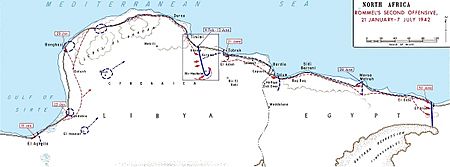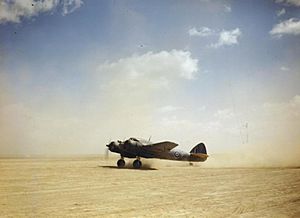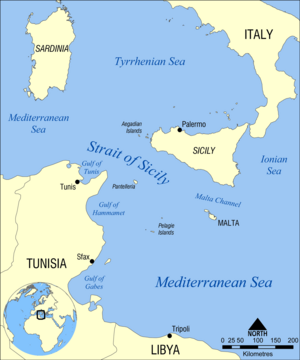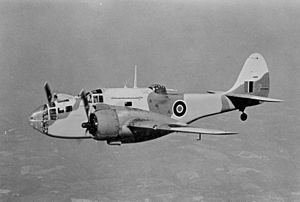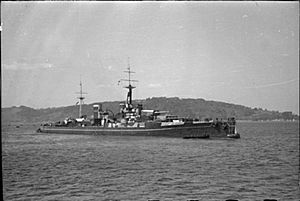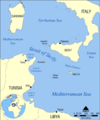Operation Vigorous facts for kids
Quick facts for kids Operation Vigorous |
|||||||
|---|---|---|---|---|---|---|---|
| Part of the Battle of the Mediterranean of the Second World War | |||||||
 Relief map of the Mediterranean Sea |
|||||||
|
|||||||
| Belligerents | |||||||
| Commanders and leaders | |||||||
| Philip Vian | Angelo Iachino | ||||||
| Strength | |||||||
| 8 light cruisers 26 destroyers 9 submarines 2 minesweepers 4 corvettes 2 rescue ships 4 motor torpedo boats 11 merchant ships 1 auxiliary ship |
2 battleships 2 heavy cruisers 2 light cruisers 12 destroyers 6 E-boats 2 U-boats c. 220 aircraft |
||||||
| Casualties and losses | |||||||
| 1 light cruiser sunk 3 destroyers sunk 2 merchant ships sunk 1 MTB sunk 3 cruisers damaged 2 merchant ships damaged c. 200 killed |
1 heavy cruiser sunk 1 battleship damaged 21 aircraft shot down c. 600 killed |
||||||
Operation Vigorous was a British plan during World War II. Its goal was to protect a group of supply ships, called a convoy, heading to Malta. This convoy, named MW11, sailed from the eastern Mediterranean Sea. The operation took place from June 11 to 16, 1942.
Vigorous was part of a bigger plan called Operation Julius. Another convoy, Operation Harpoon, sailed at the same time from Gibraltar. The British hoped to trick the Italian navy into using up their fuel. They also wanted to expose them to attacks from submarines and planes.
On June 12, Italian and German (Axis) planes attacked the convoy. One damaged ship had to turn back. A US military officer accidentally shared British plans. He sent secret messages that the Italian military had already decoded.
The convoy sailed through a dangerous area called "Bomb Alley." This was between Crete and Cyrenaica. Axis planes, torpedo boats, and submarines attacked them. Then, a large Italian battle fleet sailed from Taranto. The British did not have battleships or aircraft carriers. They relied on planes and submarines to fight off the Italian fleet. Only one Italian heavy cruiser was sunk.
When the Italian battleships got close, the British convoy was ordered to turn back. They hoped the Italians would suffer more losses. But little damage was done. After turning back and forth several times, the convoy returned to Alexandria. Operation Vigorous failed. Only two supply ships from the other convoy, Operation Harpoon, reached Malta.
Without air cover, the central Mediterranean became too dangerous for British ships. Malta could not be used as a base for attacks. The British had to send supplies by submarine. No more convoys were tried from the eastern Mediterranean until October. By then, the British army had taken control of Libya.
Contents
- Why Malta Was Important
- Getting Ready for the Convoy
- The Convoy's Journey
- What Happened Next
- Ships Involved
- Images for kids
- See also
Why Malta Was Important
Malta Under Attack
Malta is a small island in the Mediterranean Sea. It was very important during World War II. It was a British base that could attack Axis supply ships. These ships were bringing supplies to North Africa.
The Siege of Malta, 1942
By April 1942, Axis planes had heavily bombed Malta. They destroyed docks, ships, planes, and airfields. Then, they started bombing places needed for an invasion. These included camps, barracks, and warehouses. German bombing stopped suddenly after April 18. Italian bombers then took over.
The bombing caused a lot of damage. Over 11,000 buildings were hit. About 300 civilians were killed. Food supplies were also cut. Meat, fats, sugar, and bread rations were reduced. Many ships in the harbor were sunk or damaged. Malta could no longer be used as a base for attacks.
British Attacks from Malta
From December 1941, German bombing made Malta less effective. British spies learned that more Italian ships were getting through. By February 1942, 11 Axis supply ships reached Tripoli without escorts.
The British lost many planes and ships. On April 14, five Malta planes were shot down. A submarine, HMS Upholder, was also lost. In February and March, about 9% of Axis supplies were lost. But in April, less than 1% were lost.
By late April, British leaders decided not to send a convoy to Malta in May. They knew the Italian fleet would attack. They did not have enough battleships or aircraft carriers to protect a convoy. They hoped to send more supplies later. This would happen if the British army captured airfields in Libya.
The Axis Plan to Invade Malta
The Axis powers had a plan to invade Malta. It was called Operation Hercules. In 1942, Germany sent more planes to Sicily. They also bombed Malta heavily. This made people think an invasion was coming.
However, Hitler was not very keen on the invasion. He worried the Italian navy might not fully support it. In mid-June, the Axis captured Tobruk. This made the invasion seem unnecessary. Hitler and Mussolini decided to focus on chasing the British into Egypt. This meant cancelling Operation Hercules.
The Desert War in North Africa
After a successful operation in late 1941, the British army advanced far into Libya. They captured airfields that could help protect Malta convoys. But the Axis forces attacked first in January 1942. The British were forced to retreat.
At the Battle of Gazala in May 1942, the Axis attacked again. The British army was forced to retreat towards Tobruk. This meant the British air force lost important airfields in Libya. These airfields were needed to provide air cover for the Malta convoys.
Getting Ready for the Convoy
Operation Julius: The Big Plan
Two weeks before the convoys, a British aircraft carrier, HMS Eagle, delivered 63 Spitfire fighter planes to Malta. This brought the total to 95 working fighters. Air operations for the two convoys began on May 24. British bombers from Malta started attacking airfields and ports in Italy.
On June 11, more planes arrived in Malta. These included torpedo bombers and reconnaissance planes. Planes from Gibraltar, Malta, and Egypt also started searching for the Italian fleet. Long-range fighters were to protect the convoy as it moved. Other bombers would attack Axis airfields in North Africa.
Operation Vigorous: The Eastern Convoy
| Type | Malta | Egypt |
|---|---|---|
| Albacore | 830 NAS | 821, 826 NAS |
| Baltimore | 69 | – |
| Beaufort | 217 | 39 |
| Blenheim | – | 203 13 Hellenic |
| Hudson | – | 459 RAAF |
| Maryland | – | 203 |
| Spitfire | 2 PRU | – |
| Sunderland | – | 230 |
| Swordfish (ASV) |
– | 815 NAS |
| Wellesley | – | 47 |
| Wellington (torpedo) |
38 | – |
| Wellington (ASV) |
221 det. | 221 |
Operation Vigorous was a joint effort by the Royal Navy and the Royal Air Force. Admiral Philip Vian was in charge of the convoy and its escorts. In March 1942, British escorts had fought off the Italian fleet. But in June, with longer daylight hours, it would be harder.
The British battleships HMS Queen Elizabeth and HMS Valiant were out of action. So, the convoy's success depended on planes and submarines damaging the Italian fleet. The British considered bringing more battleships and aircraft carriers. But the risk of air attack was too high.
The convoy escort force was very large. It included several cruisers and 26 destroyers. Four corvettes, two minesweepers, and four motor torpedo boats also joined. Two rescue ships were also part of the group. A former battleship, HMS Centurion, was used as a decoy. It was fitted with anti-aircraft guns. Nine submarines were also positioned to protect the convoy.
Operation Harpoon: The Western Convoy
Operation Harpoon was the convoy sailing from Gibraltar. It started on June 4. Five merchant ships left Scotland. They were supposedly going to Malta via Africa. But it became clear they were heading to Malta directly.
This convoy had strong protection. It included three cruisers and ten destroyers. A battleship and two aircraft carriers were also part of the force. Thirteen submarines were also patrolling to ambush Italian ships.
The Italian navy had limited oil. But they learned about the British convoys from spy reports. They planned to attack both convoys. Nine submarines were sent to patrol off Algeria. Five more were near Malta. Six German torpedo boats were also waiting between Crete and Cyrenaica.
A group of Italian cruisers and destroyers waited in Palermo and Cagliari. They were ready to stop Operation Harpoon. The main Italian battle fleet was saved for the convoy from Alexandria.
The Convoy's Journey
June 11: The Decoy Convoy Sails
The eleven merchant ships were loaded at different ports. This was to keep the operation secret. Some ships had problems with their guns. Four ships, part of MW11c, sailed 36 hours early. This was a decoy operation.
They were escorted by a cruiser and eight destroyers. They sailed towards Tobruk and then turned back. The hope was to trick the Italian fleet into coming out early. This would expose them to attacks and use up their fuel. Meanwhile, the Operation Harpoon ships met off Gibraltar.
June 12: Attacks Begin
The main convoy, MW-11a, sailed from Haifa and Port Said. It had five merchant ships and escorts. One ship, Elizabeth Bakke, had to turn back due to problems. MW11b sailed from Alexandria. It included two tankers and the decoy battleship Centurion.
In the evening, MW11c was attacked by German bombers from Crete. One ship, City of Calcutta, was damaged. It had to divert to Tobruk. The decoy convoy then turned back to meet the rest of MW11. Operation Harpoon was not attacked. The Italian navy thought it was a trick.
June 13: Convoys Meet and Attacks Continue
The three convoy groups met near Mersa Matruh. The weather got worse. The towed motor torpedo boats had to be cut loose. One was sunk. A small raiding party landed on Crete. They damaged about 20 German planes at Maleme airfield.
After dark, Axis planes kept lighting up the convoy with flares. They also dropped bombs. British fighters arrived after dawn. British bombers attacked Axis airfields in North Africa. In Libya, the British army was losing the Battle of Gazala. They were ordered to retreat the next day.
Operation Harpoon continued. More Italian planes were sent to Sardinia. But they lost contact with the convoy. Two Italian cruisers and three destroyers sailed from Cagliari. They were ready to stop any fast British ships.
June 14: Heavy Bombing and Italian Fleet Sighted
Dust storms in Libya grounded many bombers. The convoy escorts reorganized. More destroyers joined the group. Some British ships developed engine trouble. They were sent to Tobruk. Near Tobruk, German dive-bombers attacked. One ship, Aagtekirk, was hit and caught fire. It later burned out.
The rest of the convoy was protected by British fighters. These planes were diverted from the Battle of Gazala. Later, about 60-70 bombers attacked the convoy seven times. They were opposed by only a few long-range British fighters. One merchant ship, Bhutan, was hit three times and sank. Rescue ships picked up 153 crew members.
A German submarine, U-77, attacked a British destroyer. The torpedo missed. As night fell, the bombing stopped. The escort force moved into night formation. Flares from Axis planes kept torpedo boats away. But the British crews were very tired. They had used a lot of anti-aircraft ammunition.
At 6:45 p.m., a British plane spotted the Italian fleet. It had two battleships, two heavy cruisers, and two light cruisers. They were sailing from Taranto. The British commander, Vian, asked to turn back. He knew his escorts could not protect the merchant ships for another long day. The British convoy was ordered to turn back.
Meanwhile, Operation Harpoon was also under heavy attack. Italian bombers and torpedo-bombers attacked. One merchant ship was sunk, and a cruiser was damaged.
Night, June 14/15: Torpedo Attacks
The order to turn back was given at 1:45 a.m. This was a risky move for so many tired ships. German torpedo boats attacked the British cruisers. HMS Newcastle was hit by a torpedo. It was damaged but managed to continue. The destroyer HMS Hasty was also hit and badly damaged. It had to be sunk by another British ship.
As the sun rose, the convoy was heading east. British torpedo-bombers from Malta found the Italian fleet. They attacked. One torpedo hit the Italian cruiser Trento. It stopped moving. Other British planes also attacked the battleships.
June 15: More Attacks and Retreat
Morning Attacks
The Italian fleet was in an area where British submarines were patrolling. One submarine, HMS Umbra, found the Italian ships. It fired torpedoes at the battleship Vittorio Veneto, but missed. Other submarines also tried to attack. At 10:06 a.m., HMS Umbra hit the damaged Italian cruiser Trento with two more torpedoes. The ship sank an hour later.
The Italian battle fleet continued south. US and British bombers attacked them. One bomb hit the battleship Littorio, but it caused little damage. More British planes attacked, but many were shot down by German fighters.
The British command in Alexandria received reports slowly. The British convoy was ordered to turn back towards Malta again. But if the Italian ships attacked, the merchant ships were to be abandoned. The escorts would try to escape.
Later, the British command learned about the torpedo hits on the Italian fleet. They ordered the convoy to turn for Malta again. But they also gave the commander, Vian, freedom to act.
Operation Harpoon was intercepted by Italian cruisers. British destroyers bravely attacked. The Italian ships broke off their attack. Air attacks on the convoy continued. Two ships were damaged, and one was sunk. The Italian cruisers reappeared and attacked a damaged British destroyer. It was later sunk by a plane. The two remaining merchant ships reached Malta that night.
Afternoon Attacks
The order to turn for Malta reached Vian late. Axis bombers attacked the convoy again. Dive-bombers attacked the escorts. Some merchant ships were slightly damaged. More Axis planes attacked. One British destroyer, HMS Airedale, was disabled. It had to be sunk by another British ship.
The Italian ships were close to the British convoy. But the Italian navy command ordered them to turn away. They were only 110 miles from the convoy. British planes reported the Italian fleet turning away. The British convoy was ordered to turn for Malta again.
The convoy and escorts were attacked again by dive-bombers and torpedo planes. Three ships had near misses. Radar-guided anti-aircraft fire made the attackers careful. One British ship, HMS Nestor, was badly damaged. German bombers flew many missions against the convoy. This gave the British army a break as they retreated in Libya.
Evening: Operation Vigorous Abandoned
The British commander, Vian, reported that his ships had little ammunition left. At 8:53 p.m., the British command ordered Operation Vigorous to be abandoned. The ships were to return to Alexandria.
The Italian battle fleet continued to move away. British submarines tried to intercept them. But British signals were very slow. Another British plane found the Italian fleet. British torpedo-bombers attacked again. One torpedo hit the Italian battleship Littorio, but it caused only minor damage.
Night, June 15/16 and June 16: Return to Port
Another Axis air attack had no effect. During the night, the convoy sailed east. The damaged HMS Nestor fell behind. It was being towed by another destroyer. At 1:27 a.m., a German submarine, U-205, torpedoed the British cruiser Hermione. It sank, and 88 men were killed.
Two more air attacks were made on Nestor and its escorts. The tow line broke. With dawn approaching, the captain of Nestor decided the risk was too great. Nestor was sunk at 7:00 a.m. The other destroyers caught up with the convoy. The convoy reached Alexandria that evening.
What Happened Next
Losses from the Operation
During Operation Vigorous, the British lost:
- The cruiser Hermione
- Three destroyers: Airedale, Hasty, and Nestor
- Two merchant ships
- Three cruisers, a destroyer, and a corvette were damaged.
British planes and submarines sank the Italian cruiser Trento. They also damaged the battleship Littorio. British gunners shot down 21 Axis planes.
Operation Harpoon also had losses. Two destroyers were sunk. A cruiser, three destroyers, and a minesweeper were damaged. The British lost 12 planes.
Later Operations
In July, British submarines delivered aviation fuel and ammunition to Malta. More Spitfire fighters were flown to Malta. By the end of July, the mine danger near Malta was reduced.
Axis bombers continued to attack Malta. They destroyed many planes on the ground. But British fighters at Malta had more success. They started intercepting raids further out at sea.
Operation Pedestal was another British operation to supply Malta in August. Despite many losses, enough supplies reached Malta. This helped the island resist. The fuel from the ship Ohio helped Malta's air force attack Axis shipping.
After Pedestal, submarines returned to Malta. More Spitfires arrived. Italian convoys had to take longer routes. This gave British planes and ships more time to attack them. The Siege of Malta ended in October 1942. This happened after the Second Battle of El Alamein and Operation Torch. These operations allowed land-based planes to escort merchant ships to Malta.
Ships Involved
- † - ships sunk
- # - ships damaged, ## - heavily damaged
Allies
Cruisers
- Light cruisers
- HMS Newcastle ##, Birmingham #, HMS Cleopatra, Dido, Hermione†, Euryalus, Arethusa
- Light cruiser (Anti-Aircraft)
- HMS Coventry
Destroyers
- 2nd Destroyer Flotilla
- HMS Fortune, Griffin, Hotspur
- 5th Destroyer Flotilla (Hunt-class destroyer escorts):
- HMS Dulverton, Exmoor, Croome, Eridge, Airedale†, Beaufort, Hurworth, Tetcott, Aldenham
- 7th Destroyer Flotilla
- HMAS Norman, Napier, Nestor†, Nizam
- 12th Destroyer Flotilla
- HMS Pakenham, Paladin, Inconstant
- 14th Destroyer Flotilla
- HMS Jervis, Javelin, Kelvin
- 22nd Destroyer Flotilla
- HMS Hero, Hasty†, Sikh, Zulu
Corvettes (Flower-class)
- HMS Delphinium, HMS Erica, HMS Primula, HMS Snapdragon
Minesweepers (Bangor-class)
- HMS Boston, Seaham
Motor Torpedo Boats
- MTB-259†, MTB-261, MTB-262, MTB-264
Rescue ships
- Antwerp, Malines
Auxiliary ship (decommissioned battleship)
- HMS Centurion
Submarines
- HMS Proteus Thorn, Taku, Thrasher, Porpoise, Una, Uproar, Ultimatum, Umbra
Merchantmen
- MW-11A: Ajax, City of Edinburgh, City of Lincoln, m.v. City of Pretoria, Elizabeth Bakke
- MW-11B: tankers Bulkoil, Potaro #
- MW-11C: Aagtekirk†, Bhutan†, City of Calcutta #, Rembrandt
Italian
Battleships
- Littorio #, Vittorio Veneto
Heavy cruisers
- Trento†, Gorizia
Light cruisers
- Emanuele Filiberto Duca d'Aosta, Giuseppe Garibaldi
Destroyers
- Alpino, Antonio Pigafetta, Ascari, Aviere, Bersagliere, Camicia Nera, Geniere, Folgore, Freccia, Legionario, Mitragliere, Saetta
Images for kids
See also


